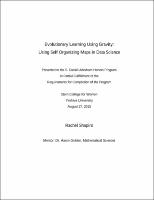Please use this identifier to cite or link to this item:
https://hdl.handle.net/20.500.12202/4196Full metadata record
| DC Field | Value | Language |
|---|---|---|
| dc.contributor.author | Shapiro, Rachel | - |
| dc.date.accessioned | 2018-11-12T19:57:36Z | - |
| dc.date.available | 2018-11-12T19:57:36Z | - |
| dc.date.issued | 2015-08 | - |
| dc.identifier.uri | https://hdl.handle.net/20.500.12202/4196 | - |
| dc.identifier.uri | https://repository.yu.edu/handle/20.500.12202/4196 | |
| dc.description | The file is restricted for YU community access only. | - |
| dc.description.abstract | The age of "Big Data" is now. About 2.5 quintillion bytes of data are created daily, a rate so much faster than ever before that ninety percent of data in existence was created in the past few years[1]. In Project Open Data, the U.S. Government makes over a hundred thousand databases "available, discoverable, and usable" to the general public[2]. It is therefore no curiosity that people are more focused today on data analysis, presentation, and interpretation. The Self Organizing Map (SOM) is one of the plethora of data analysis techniques that exist. Originally invented by Academy of Finland professor Tuevo Kohonen, the SOM uses an unsupervised learning algorithm to represent multidimensional data in lower dimensions while clustering similar data vectors in the process. These clusters can be thought of as distinct; once identified, they can be extracted and examined in isolation. The original algorithm and its many variations have been applied to solve many problems such as data mining[3], image compression[4], and machine learning[5], as well as to find patterns in data in various fields including geography[6], finance[7], biology[8], and astronomy[9]. This paper will explore the use of SOMs in data analysis. In particular, it will focus on the performance efficiency and reliance on the user defined operational conditions with the intention of determining how to create a more autonomous and efficient SOM. | en_US |
| dc.description.sponsorship | S. Daniel Abraham Honors Program | en_US |
| dc.language.iso | en_US | en_US |
| dc.publisher | Stern College for Women | en_US |
| dc.rights | Attribution-NonCommercial-NoDerivs 3.0 United States | * |
| dc.rights.uri | http://creativecommons.org/licenses/by-nc-nd/3.0/us/ | * |
| dc.subject | Self-organizing maps. | en_US |
| dc.subject | Neural networks (Computer science) | en_US |
| dc.title | Evolutionary Learning Using Gravity: Using Self Organizing Maps in Data Science | en_US |
| dc.type | Thesis | en_US |
| Appears in Collections: | S. Daniel Abraham Honors Student Theses | |
Files in This Item:
| File | Description | Size | Format | |
|---|---|---|---|---|
| Rachel-Shapiro.pdf Restricted Access | 1.56 MB | Adobe PDF |  View/Open |
This item is licensed under a Creative Commons License

